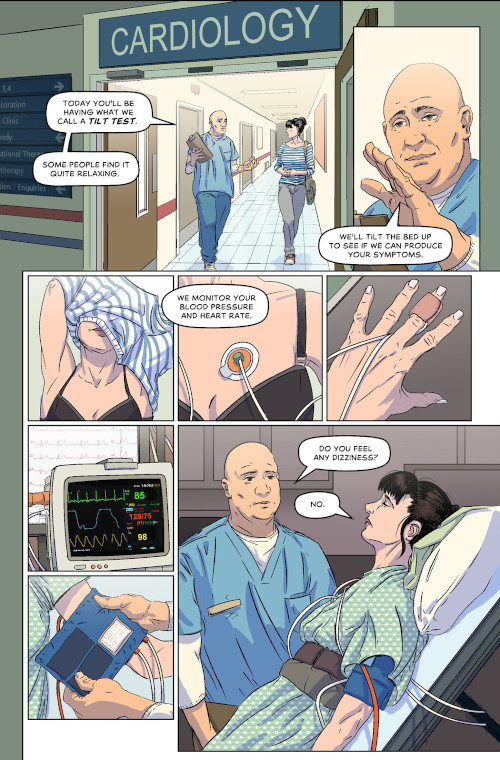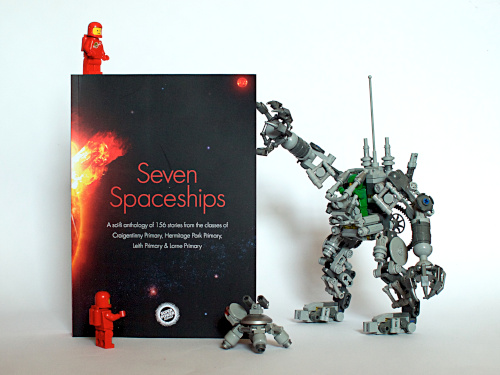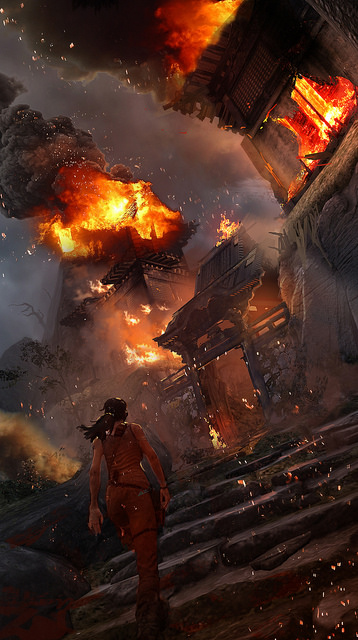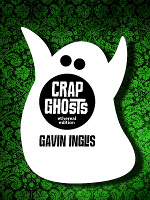Blog
Not There
5th February 2021
A comic book about Functional Neurological Disorder.In 2017 I began an arts residency in the Department of Clinical Neurosciences at the Western General Hospital. It was a productive period which produced new fiction, research into a pioneering Edinburgh neurosurgeon, a story set to smells, a Book Festival show and more.

But there was something missing. Seeing the people working there — technicians, neurologists, occupational health, surgeons, nurses — I felt a need to contribute somehow. Of course neuroscience is not a discipline where you can become useful quickly, and my early reading drove that home.
I had lunch with Professor Peter Sandercock and he suggested I look into the specialised area of Functional Neurological Disorder (FND). This is a condition where there is a problem with the functioning of the nervous system: how the brain and body send and receive messages, rather than detectable damage caused by disease. This makes an FND difficult to diagnose and sometimes means patients struggle to get help. Symptoms vary from visual disturbances to uncontrollable muscle contractions.
Understanding your FND is an important step towards tackling it. This was part of the clinical work at DCN — and perhaps something I could help with.
Time for more research. I met Professor Jon Stone, a leading figure in the field who turned out to be exceptionally supportive and patient throughout the process. His site neurosymptoms.org is a superb resource for understanding FNDs. I attended a three-day conference and understood more of the papers than I expected to. It let me meet some patients and see the breadth of work being done on FND. Finally, as with Hana Feels, I went deep on patients’ own accounts of their experience.
At first I planned to write a radio play and try to place it with the BBC. But there is already a powerful FND play, Still Ill, which I got the chance to see at the New Diorama Theatre. For a therapeutic contribution, what was needed was something that patients could access immediately, while they were struggling to understand their condition. So I came up with the idea of a short graphic novel; a comic.
I created Steph, a woman who suffers dissociative attacks and blacks out in public. Dissociative attacks are one of the more common FND symptoms. They let me focus on the effect her condition had on Steph’s public and private life. I wrote the draft script in a few days, suspecting it would change throughout the process.
For visuals, I approached Fin Cramb, an Edinburgh artist known for his atmospheric colour work. He was full of strong ideas about layout and imagery. Over meetings which revolved around chips and blue cheese sauce, we worked things out. Three of those early pages were exhibited at the City Arts Centre. Two pages were added to the script, expanding the range of tests Steph went through.

I decided to letter the pages myself. This is a separate job, an art with its own conventions and subtleties. I wanted to pick up the skill, and also thought it might make me a better comics writer if I got my hands dirty with placement. It was slow and painstaking, but it was fascinating too — lettering is the moment when the pages shift from a visual representation to the live and breathing story you envisaged. Often in trying to fit a balloon to a small corner, I would realise it didn’t need all its word content; and once or twice I realised Fin’s art told the story without needing any additional words.
Every creative stage was a learning process, and we often asked advice from NHS staff. Besides our neurological experts, thanks are due to a psychiatrist, MRI techs, and a paramedic. Our feedback ranged from nuances of consultation language to getting the paramedic character’s boots correct!
There will be some physical copies of Not There eventually, and more digital distribution. But for now you can download Not There as a PDF from Ginkgo Projects.
Alternarratives
28th September 2020
A fun collision of story, music and code.Music has been part of my spoken word for a few years now. When perfectly synchronised, it highlights mood and dramatic moments. When it’s live and a bit rough, there’s the possibility of happy accidents: odd juxtapositions that create exquisite moments that can’t be easily reproduced.
I feel really sad when I meet somebody who won’t touch anything that makes music. It’s usually because they had a bad experience in school, with a music teacher who told them they were no good; or because they think that knowing scales and Italian terms is a necessary prerequisite to making the first sound. Sure, nobody becomes a virtuoso without that stuff. But there’s so much pleasure and satisfaction to be gained from earlier steps.

Of course I was going to apply to the Alternarratives programme from Nesta. This was a challenge to reimagine short-form storytelling for young people aged 11–16 and I spend all my time thinking about different ways to tell stories. My first ideas concerned hypertext and interactive fiction, but one day I looked at Ableton Live and thought: how about a simple DJ interface to control music beneath a story? One where you can’t screw up?
The result was The Reader Remix. At first I pitched a project with existing software and a tactile MIDI controller. But just as we were approaching our first in-person meeting, COVID-19 arrived. Everything went online. I wasn’t hit as hard as Viccy Adams, whose project told a story through physical geocaches. But I had to retool quickly for online delivery.
Thanks to some rusty Javascript and the howler.js library, I was able to get a prototype working online. Development was pretty fluid: two decks didn’t provide enough variety so I added a third deck. The pitched story felt too slow, so I wrote a new piece about a first-time teenage DJ racing to do a set at a slowly collapsing party. I composed eighteen music loops where all the combinations worked, more or less. And Rhiannon Grist recorded a great female voice version of the story so that readers could choose.
If you enjoy The Reader Remix, why not try the other projects which are still available on BBC Taster? I suggest starting with Jasmine Richards’ lush multimedia story Project Earworm or Thomas McMullan’s computer desktop mystery The Unsettled Ground.
I felt privileged to have the time and support to work on Reader Remix as part of Alternarratives. Those who tried it seemed to enjoy the experience, but the other projects were so slick that I didn’t expect what happened: it won. This means that I can work on it some more; the next stage of development is to make it available for download and customisation, so teenage (and adult) creators can replace my content with their own stories and music loops and publish the results. I can’t wait to try them.
Mentoring 2020
2nd January 2020
A positive contribution for a new year.
I spent a lot of 2019 feeling frustrated about politics, toxic discourse and commercialisation. To put things back together, 2020 needs to be a year about grassroots positivity and building community. So I've decided to offer a little free mentoring to six new or emerging local writers. I don’t have all the answers, but I’m a professional writer who has also been teaching for fifteen years. I learned a few things along the way, and I’m happy to share.
This is what I can help with:
- Short fiction, particularly flash fiction
- Approaching and structuring longer projects
- Interactive stories: paper, digital or games
- Spoken word, with or without music
This is how it will work:
I will choose a writer for each two month block, Jan/Feb, Mar/Apr etc. I’ll make the decision based on where I feel I can be of the most use. In the first month, you’ll send me something to read, then we’ll meet for about an hour and have a chat. I’ll buy you a coffee or whatever, and make a few suggestions. In the second month, we’ll meet up again and see how it went. That’s it. I promise to be encouraging, and to give you a shout out on Twitter after the sessions if you like. You promise to be committed to your work.
If you’re not sure whether you qualify, you probably do. The only restrictions are: I’ll want to meet in/near Edinburgh, or maybe Glasgow city centre; and I can’t offer help with poetry, sorry.
If it sounds like this would be useful, drop me a line. Don’t worry about a CV or anything formal. And don’t overthink it. Just write a couple of paragraphs telling me what you’ve done so far and what you would like help with. Remember to include your email address. I’ll pencil in three writers for the first half of the year, and we’ll take it from there.
Thanks, and hope this is a good year for you.
Seven Spaceships
30th June 2019
Colonising distant worlds with Primary 7 writers.
One of the more rewarding things I’ve done this year is to volunteer with the Super Power Agency. This is an Edinburgh organisation patterned after San Francisco’s 826 Valencia. It goes into schools and runs workshop programmes to encourage creative writing from kids who otherwise might lack the confidence to try.
The latest project was called Seven Spaceships. Each of our Primary 7 participants created a character on a colony ship, which is reaching the end of its seven-year journey to a new world, Alba Prime. On one level, this is a great platform for imaginative science fiction adventures. On another, it’s an opportunity for P7s to explore their feelings about the transition to high school. In classrooms you can see the difference between Primary 7 and Secondary 2; the uncomplicated enthusiasm melts away and is replaced by something more sceptical and self-conscious.
Seven schools are represented in the resulting (358 page!) book, 156 stories in total. A surprising number of the authors regard fast food outlets as an essential resource on any spaceship. From my crew, Lorne Primary, you can read about:
- a vampire who just wants to build a videogame station
- a giant eyeball that enjoys checking temperatures
- a reconditioned boat business
- a grandfather who tried to ruin coffee and died as a result
- conjoined twins who rescue a prisoner from Pluto
- a character named Aclzy21cnox76tskn38na768c0b8n982 whose clone eats the moon
It was quite something to see the seven crews assembled in Leith Academy to get their hands on the book and collectively become published authors. The new planet was a tough environment for those who read out loud: a massive, acoustically dead space and alien rain battering on the roof. But the Edinburgh International Book Festival has the same problems; and it didn’t seem to matter to the colonists at all.
If you think you could use 156 uplifting stories in one volume, the book should be available on the SPA website. But if you can spare some time during the week, you could volunteer and help to create the next project. I guarantee it will be an exhausting and highly satisfying experience.
Games Lab
17th October 2018
Playful weekends with the Scottish Book Trust.I spent the last couple of weekends curating and presenting a Games Lab with the Scottish Book Trust. Many of the participants thanked me for my time, but in truth, I love doing this stuff.
The Labs are the Trust’s events for professional writers interesting in exploring another field. We selected ten participants: novelists, screenwriters, theatre makers and comicbook creators. The group has to be kept tight to allow for personal attention and to encourage deep networking.
This year I’ve taught interactive writing quite a bit: Writing Fiction for New Media at the University of Edinburgh; the Interactive Fiction Summer School at the British Library; and a day in Belgium with the fanTALES European consortium, using collaborative IF to encourage schoolchildren to write. Some stuff always comes up, like the design patterns of Sam Kabo Ashwell, or the delayed branching discussed by Dan Fabulich in How To Write A Long Interactive Novel That Doesn’t Suck. But the lab needed a wider perspective, so I invited guest speakers.

Olivia Wood is on the staff of sinister indie Failbetter Games, and also freelances, recently on Where the Water Tastes like Wine. Although a terrific writer, she is perhaps best known in the industry for her editing work. Olivia advised on text — keep it short, avoid the word “strange’ — but also on the use of visuals and environmental cues to tell a story. Olivia admitted that being edited can be a painful experience, but after the edit process, any problems with the text are her problems, not yours.
Perhaps the most prominent name in games writing is Rhianna Pratchett. Known for 2013’s unflinching Tomb Raider reboot and the cheerfully evil Overlord, she also worked on Thief, Bioshock Infinite and Prince of Persia. Rhianna talked about writing for AAA games as a hired gun, and introduced the wonderful job description of “narrative paramedic” for games writers called in when the story is already breathing its last. She recalled early games of Mazogs on the ZX81, with pixels about a centimetre across. Her new title, Lost Words, uses movable words for a platformer set inside a young girl’s diary.
I wanted to get someone doing individual, leftfield work, and Simon Meek fit perfectly. Designer in Residence at the new V&A Dundee, he creates playable stories which draw more from graphic design and film than video games, and his approach appealed to the visual artists in the room. Simon talked about previous projects: a digital adaptation of Buchan’s The 39 Steps and Beckett, an uneasy detective story with a powerful narrative style. His new work, Marnie Wakes, is a digital memoir collecting monologues designed to be read in any order — also presented through video and live performance.
I sometimes feel guilty for doing the bulk of my work for publishers outside Scotland, and Brian Baglow was the perfect guide to the national scene. Previously a writer, game designer and producer, he lectures on interactive/digital media at Napier University, recently took up a new role at dev training house CodeClan, and is the brain behind the Scottish Games Network. Brian talked facts, figures and trends in the industry and ways in which writers might fit. He also mentioned writing missions in 1997 for a small open-world driving game named Grand Theft Auto, which apparently became very popular.
Our final speaker was a blast of energy on a drizzly Saturday morning — crime favourite Chris Brookmyre. His background in competitive first-person shooters influenced many of his books, such as Pandaemonium and One Fine Day in the Middle of the Night, and he got the chance to work on one with Bedlam. Chris had a lot to say about turning budget limitations into creative opportunities, and it was refreshing to hear that he’d had a positive experience dipping into game development. I also enjoyed his references to Spectrum games, and the joy of exploration over actually trying to complete the thing.
The event wasn’t all theory — the participants worked on their own games in Twine between sessions, and the Lab wound up with a chance to circulate and try their new creations. An early prompt about wine theft inspired three entirely different games: a gallery heist, party pilfering and a domestic betrayal. We also infiltrated a cult with suspiciously good coffee and met a terrifying little girl whose drawings seemed imbued with cosmic horror.
[ Older entries ]
